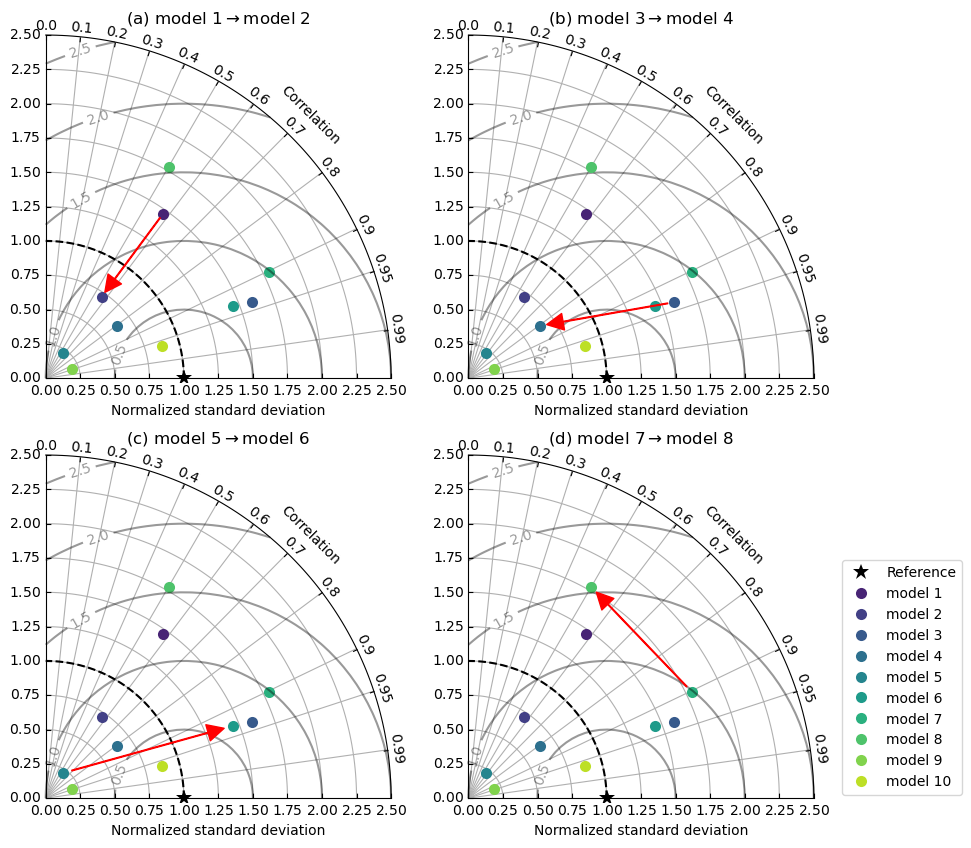Taylor Diagram: Usage Example
This notebook generates a Taylor Diagram using PMP from random sample data.
Reference for Taylor Diagram: Taylor, K. E. (2001), Summarizing multiple aspects of model performance in a single diagram, J. Geophys. Res., 106(D7), 7183–7192, http://dx.doi.org/10.1029/2000JD900719
Written by Jiwoo Lee (LLNL/PCMDI)
Last update: 2022. 10
Table of Contents
Generate a sample dataset
Plot Taylor Diagram
2.1 Basic example with labeling all models
2.2 Normalize standard deviation
2.3 Some customizations
2.4 Group models and label by the group
2.5 Add model-comparing arrows
2.6 Multi-panel plot
1. Generate a sample dataset
Back to the Tabel of Contents
Presume a sample dataset from 10 models.
[1]:
import numpy as np
stddev = np.random.uniform(low=1, high=10, size=(10,)) # Generate 10 random numbers between 1 and 10
corrcoeff = np.random.uniform(low=0.5, high=1, size=(10,)) # Generate 10 random numbers between 0.5 and 1
refstd = 5
models = ['model '+str(i) for i in range(1,11)]
2. Plot Taylor Diagram
Back to the Tabel of Contents
[2]:
import matplotlib.pyplot as plt
from pcmdi_metrics.graphics import TaylorDiagram
Usage of TaylorDiagram function:
Parameters
stddev : numpy.ndarray
an array of standard deviations
corrcoef : numpy.ndarray
an array of correlation coefficients
refstd : float
the reference standard deviation
fig : matplotlib figure, optional
the matplotlib figure
rect : a 3-digit integer, optional
ax subplot rect, , default is 111, which indicate the figure has 1 row, 1 column, and this plot is the first plot.
https://matplotlib.org/stable/api/_as_gen/matplotlib.pyplot.subplot.html
https://matplotlib.org/stable/api/figure_api.html#matplotlib.figure.Figure.add_subplot
title : string, optional
title for the plot
titleprops_dict : dict, optional
title property dict (e.g., fontsize)
cmap : string, optional
a name of matplotlib colormap
https://matplotlib.org/stable/gallery/color/colormap_reference.html
colors : array, optional
an array or list of colors for each element of the input arrays
if colors is given, it will override cmap
normalize : bool, optional
disable to skip normalization of the standard deviation
default is False
labels : list, optional
list of text for labels
markers : list, optional
list of marker type
markersizes : list, optional
list of integer for marker size
closed_marker : bool, optional
closed marker or opened marker
default - True
markercloses : list of bool, optional
When closed_marker is False but you still want to have a few closed markers among opened markers, provide list of True (close) or False (open)
default - None
zorders : list, optional
list of integer for zorder
ref_label : str, optional
label for reference data
smax : int or float, optional
maximum of axis range for (normalized) standard deviation
compare_models : list of tuples, optional
list of pair of two models to compare by showing arrows
arrowprops_dict: dict, optional
dict for matplotlib annotation arrowprops for compare_models arrow
See https://matplotlib.org/stable/tutorials/text/annotations.html for details
annotate_text : string, optional
text to place at the begining of the comparing arrow
radial_axis_title : string, optional
axis title for radial axis
default - Standard deviation (when normalize=False) or Normalized standard deviation (when normalize=True)
angular_axis_title : string, optional
axis title for angular axis
default - Correlation
grid : bool, optional
grid line in plot
default - True
debug : bool, optional
default - False
if true print some interim results for debugging purpose
Return
fig : matplotlib figure
the matplotlib figure
ax : matplotlib axis
the matplotlib axis
2.1 Basic example with labeling all models
Back to the Tabel of Contents
[3]:
fig = plt.figure(figsize=(5,5))
fig, ax = TaylorDiagram(stddev, corrcoeff, refstd,
fig=fig,
labels=models,
ref_label='Reference'
)
ax.legend(bbox_to_anchor=(1.05, 0), loc='lower left', ncol=2)
fig.suptitle('Example Taylor Diagram', fontsize=20)
[3]:
Text(0.5, 0.98, 'Example Taylor Diagram')
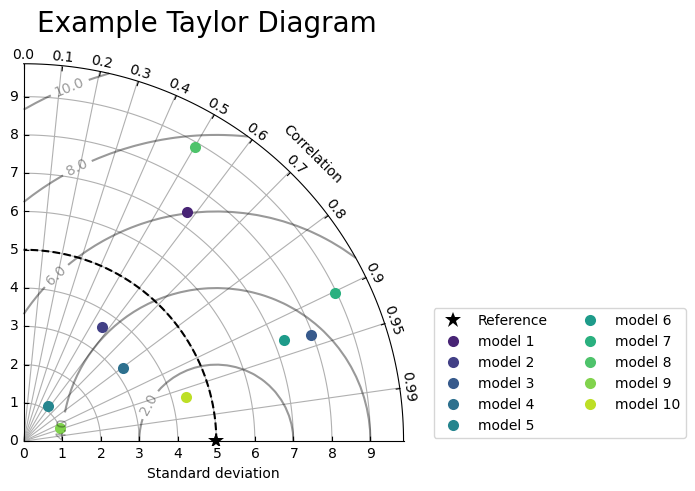
2.2 Normalize standard deviation
Back to the Tabel of Contents
Normalize standard deviation (radial axis) by that of the reference dataset
[4]:
fig = plt.figure(figsize=(5,5))
fig, ax = TaylorDiagram(stddev, corrcoeff, refstd,
fig=fig,
normalize=True,
labels=models,
ref_label='Reference'
)
ax.legend(bbox_to_anchor=(1.05, 0), loc='lower left', ncol=2)
fig.suptitle('Example Taylor Diagram', fontsize=20)
[4]:
Text(0.5, 0.98, 'Example Taylor Diagram')
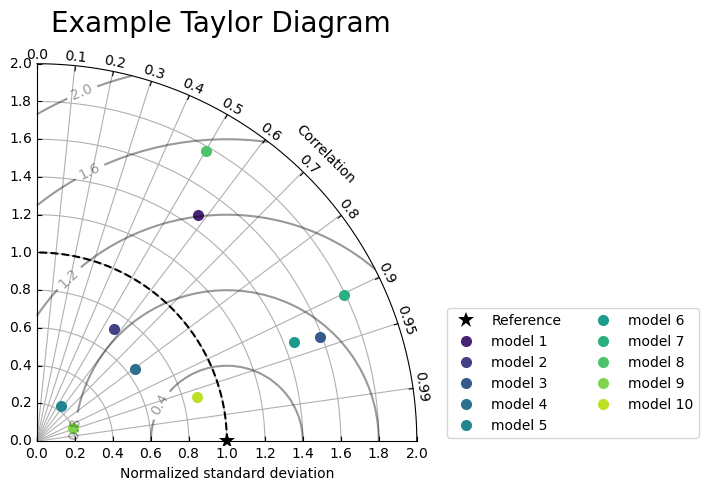
2.3 Some customizations
Back to the Tabel of Contents
[5]:
fig = plt.figure(figsize=(5,5))
fig, ax = TaylorDiagram(stddev, corrcoeff, refstd,
fig=fig,
normalize=True,
labels=models,
smax=3, # Adjust radial axis range
cmap='rainbow', # matplotlib colormap
closed_marker=False, # Change markers to be opened shape
title='Test title', # Add subplot title
ref_label='Ref Data A', # Alter reference data label
grid=False, # Turn off grid lines
)
ax.legend(bbox_to_anchor=(1.05, 0), loc='lower left', ncol=2)
fig.suptitle('Example Taylor Diagram', fontsize=20)
[5]:
Text(0.5, 0.98, 'Example Taylor Diagram')
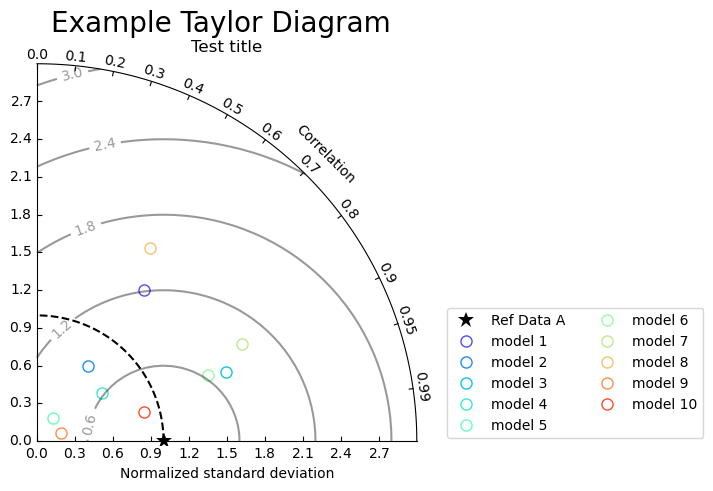
2.4 Group models and label by the group
Back to the Tabel of Contents
[6]:
fig = plt.figure(figsize=(5,5))
colors1 = ['red'] * int(len(models)/2) # For the first half models
colors2 = ['blue'] * int(len(models)/2) # For the second half models
markers1 = ['o'] * int(len(models)/2)
markers2 = ['s'] * int(len(models)/2)
markersizes1 = [5] * int(len(models)/2)
markersizes2 = [10] * int(len(models)/2)
labels1 = ['Group1 models'] + [None] * int(len(models)/2 - 1)
labels2 = ['Group2 models'] + [None] * int(len(models)/2 - 1)
# combine colors, markers, markersizes, and labels
colors_new = colors1 + colors2
markers_new = markers1 + markers2
markersizes_new = markersizes1 + markersizes2
labels_new = labels1 + labels2
# Generate plot
fig, ax = TaylorDiagram(stddev, corrcoeff, refstd, fig=fig,
colors=colors_new,
normalize=True,
labels=labels_new,
ref_label='Reference',
markers=markers_new,
markersizes=markersizes_new
)
ax.legend(bbox_to_anchor=(1.05, 0), loc='lower left', ncol=1)
fig.suptitle('Example Taylor Diagram', fontsize=20)
[6]:
Text(0.5, 0.98, 'Example Taylor Diagram')
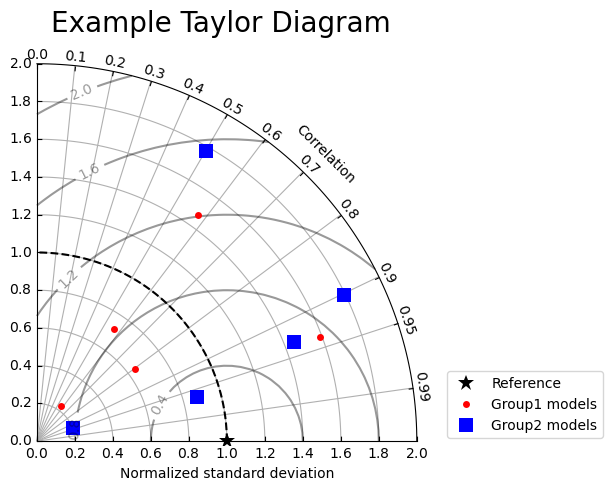
2.5 Add model-comparing arrows
Back to the Tabel of Contents
[7]:
fig = plt.figure(figsize=(5,5))
arrowprops_dict = dict(color='red',
lw=1,
width=0.5,
shrink=0.05,
zorder=100,
)
fig, ax = TaylorDiagram(stddev, corrcoeff, refstd,
fig=fig,
normalize=True,
labels=models, ref_label='Reference',
compare_models=[('model 1', 'model 2'),
('model 3', 'model 4'),
('model 5', 'model 6'),
],
arrowprops_dict=arrowprops_dict,
smax=2.5,
)
ax.legend(bbox_to_anchor=(1.05, 0), loc='lower left', ncol=1)
fig.suptitle('Example Taylor Diagram', fontsize=20)
[7]:
Text(0.5, 0.98, 'Example Taylor Diagram')
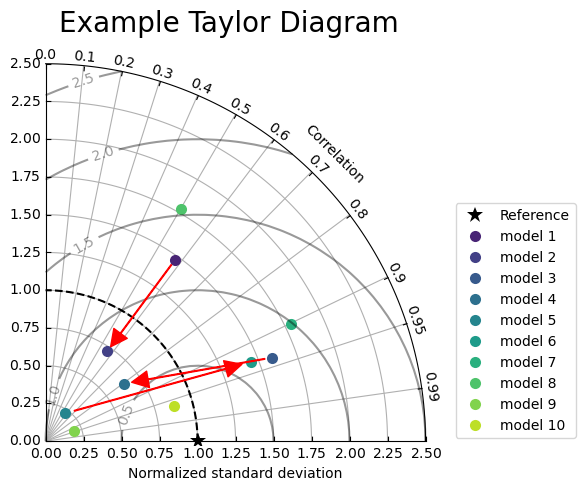
2.6 Multi-panel plot
Back to the Tabel of Contents
[8]:
fig = plt.figure(figsize=(10,10))
arrowprops_dict = dict(color='red',
lw=1,
width=0.5,
shrink=0.05,
zorder=100,
)
fig, ax1 = TaylorDiagram(stddev, corrcoeff, refstd,
fig=fig,
rect=221, # 2 row, 2 column, 1st plot
title='(a) model 1' + r'$\rightarrow$' + 'model 2',
normalize=True,
labels=models, ref_label='Reference',
compare_models=[('model 1', 'model 2')],
arrowprops_dict=arrowprops_dict,
smax=2.5,
)
fig, ax2 = TaylorDiagram(stddev, corrcoeff, refstd,
fig=fig,
rect=222, # 2 row, 2 column, 2nd plot
title='(b) model 3' + r'$\rightarrow$' + 'model 4',
normalize=True,
labels=models, ref_label='Reference',
compare_models=[('model 3', 'model 4')],
arrowprops_dict=arrowprops_dict,
smax=2.5,
)
fig, ax3 = TaylorDiagram(stddev, corrcoeff, refstd,
fig=fig,
rect=223, # 2 row, 2 column, 3rd plot
title='(c) model 5' + r'$\rightarrow$' + 'model 6',
normalize=True,
labels=models, ref_label='Reference',
compare_models=[('model 5', 'model 6')],
arrowprops_dict=arrowprops_dict,
smax=2.5,
)
fig, ax4 = TaylorDiagram(stddev, corrcoeff, refstd,
fig=fig,
rect=224, # 2 row, 2 column, 4th plot,
title='(d) model 7' + r'$\rightarrow$' + 'model 8',
normalize=True,
labels=models, ref_label='Reference',
compare_models=[('model 7', 'model 8')],
arrowprops_dict=arrowprops_dict,
smax=2.5,
)
ax4.legend(bbox_to_anchor=(1.05, 0), loc='lower left', ncol=1)
[8]:
<matplotlib.legend.Legend at 0x1672702e0>
